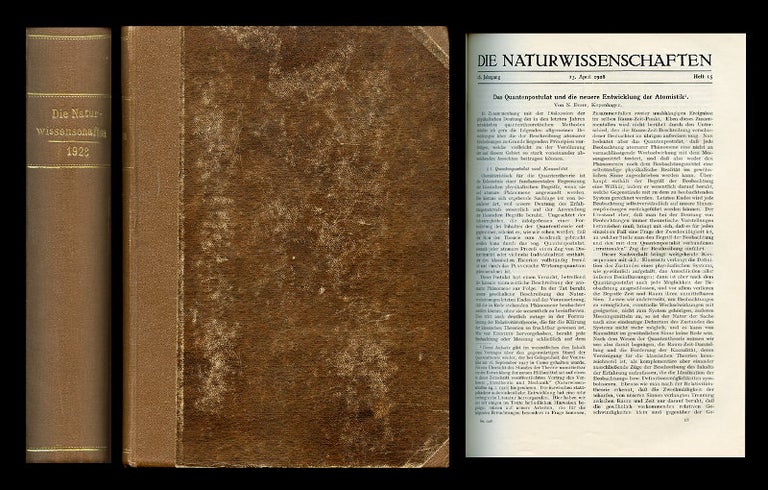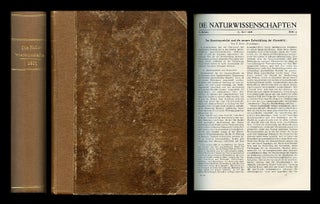Das Quantenpostulat und die neuere Entwicklung der Atomistik in Die Naturwissenschaften, Volume 16, 1928
Berlin: Springer, 1928. 1st Edition. FIRST EDITION OF BOHR’S SEMINAL PAPER ANNOUNCING HIS “COMPLEMENTARITY PRINCIPLE,” a tenet at the center of quantum mechanics stating “that matter is both particle and wave, but can only be measured to be one or the other by any given experiment, because the object being measured is affected by the measurement” (History of Physics: The Wenner Collection). Bohr’s “complementarity principle became the cornerstone of what was later referred to as the Copenhagen interpretation of quantum mechanics Bohr recognized the need for the mathematical formalism of quantum mechanics to be imbedded in a rationally coherent conceptual framework” (H. Kragh, Quantum Generations, 1999, pp. 209-210). Toward that end, his ‘complementarity’ principle went on to form the basis of what became known as the ‘Copenhagen interpretation’ of quantum mechanics.
“From the epistemological point of view, the discovery of the new type of logical relationship that complementarity represents is a major advance that radically changes our whole view of the role and meaning of science. In contrast with the nineteenth-century ideal of a description of the phenomena from which every reference to their observation would be eliminated, we have the much wider and truer prospect of an account of the phenomena in which due regard is paid to the conditions under which they can actually be observed - thereby securing the full objectivity of the description” (DSB).
“Bohr presented his ideas on complementarity for the first time at an international congress of physics in Como in the fall of 1927, commemorating the centenary of Volta’s death. On this occasion, he stressed that in the quantum world, contrary to the classical world, an observation of a system can never be made without disturbing the system. But how can we then know the state of the system? The quantum postulate would seem to imply that the classical distinction between the observer and the observed was no longer tenable. How then would it be possible to obtain objective knowledge?
“Bohr’s reflections on these and related questions led him to introduce the notion of complementarity as denoting the use of complementary but mutually exclusive viewpoints in the description of nature. Two years later, he defined the complementarity principle as ‘a new mode of description... in the sense that any given application of classical concepts precludes the simultaneous use of other classical concepts which in a different connection are equally necessary for the elucidation of phenomena’... The wave description and the particle description are complementary and thus in conflict. But Bohr argued that the physicist is still able to account unambiguously for his experiments, for it is he who chooses what to measure and thereby destroys the possibility of the realization of the conflicting aspect...
"The complementarity principle became the cornerstone of what was later referred to as the Copenhagen interpretation of quantum mechanics. Pauli even stated that quantum mechanics might be called ‘complementarity theory’, in an analogy with ‘relativity theory’. And Peierls later claimed that ‘when you refer to the Copenhagen interpretation of the mechanics what you really mean is quantum mechanics’ ... by the mid-1930s Bohr had been remarkably successful in establishing the Copenhagen view as the dominant philosophy of quantum mechanics.” (H. Kragh, 209-210). Item #466
CONDITION & DETAILS: CONDITION & DETAILS: Berlin: Springer. Die Naturwissenschaften, Volume 16, 1928. Quarto (10.75 x 7.75 inches; 269 x 194mm). [xviii], 1102, [2]. Full volume bound in brown cloth over brown marbled paper. Minor rubbing and scuffing to the boards and edge tips. Gilt lettered at the spine. Clean and bright inside and out. Very good condition.
Price: $425.00


